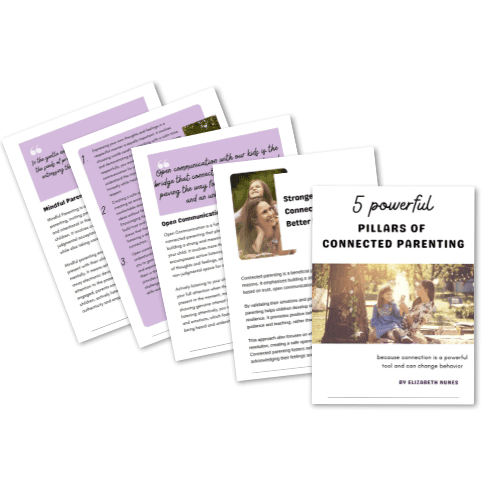170+ Ways You Can Use Positive Parenting In The Teen Years
Being a parent of a teenager can be challenging, to say the least.
You may find yourself struggling to communicate effectively with your teen, set appropriate boundaries, and encourage positive behavior.
But there’s good news: Positive Parenting can help!
Positive Parenting is an approach that focuses on building strong relationships, promoting positive behavior, and using constructive communication techniques.
By applying these principles to your interactions with your teenager, you can create a healthy and supportive environment that fosters their growth and development.
In this blog post, we’ll explore how to use Positive Parenting with teenagers.
We’ll cover everything from understanding the teenage brain and emotional development to practical tips for addressing common challenges.
So, whether you’re a new parent of a teenager or you’re looking for ways to improve your relationship with your teen, read on to learn how Positive Parenting can make a difference!
This post may contain affiliate links. Full privacy policy and disclosure here.
Ways You Can Use Positive Parenting In The Teen Years
- Maintain open communication.
- Listen actively to your teen.
- Show empathy and understanding.
- Be a good role model.
- Set clear expectations and boundaries.
- Encourage independence and responsibility.
- Offer guidance without being controlling.
- Give your teen choices when appropriate.
- Acknowledge their feelings, even if you disagree.
- Foster a sense of trust.
- Be patient and understanding of mood swings.
- Respect their privacy.
- Avoid harsh punishments.
- Focus on natural consequences when possible.
- Be consistent with rules and consequences.
- Encourage problem-solving skills.
- Help them build self-esteem.
- Provide opportunities for them to make decisions.
- Encourage healthy friendships.
- Teach conflict resolution skills.
- Promote a growth mindset.
- Be supportive of their interests and hobbies.
- Discuss peer pressure and how to handle it.
- Share your values and beliefs.
- Teach them about empathy and compassion.
- Set a curfew and discuss it with them.
- Support their academic goals.
- Help them plan for the future.
- Be present at school events and conferences.
- Encourage them to ask questions.
- Discuss the consequences of risky behavior.
- Promote a healthy lifestyle.
- Encourage them to express their opinions.
- Allow them to explore their identity.
- Be a good listener when they need to vent.
- Avoid comparing them to their peers.
- Provide constructive feedback.
- Help them manage their time.
- Teach them about finances and budgeting.
- Encourage volunteering and community involvement.
- Discuss responsible technology use.
- Set screen time limits.
- Be aware of their online activities.
- Model healthy screen time habits.
- Promote good sleep habits.
- Encourage them to set goals.
- Celebrate their achievements, big or small.
- Attend their extracurricular activities.
- Encourage them to take on responsibilities at home.
- Discuss the importance of empathy.
- Teach them to manage stress and anxiety.
- Provide guidance on handling conflicts with peers.
- Discuss the dangers of substance abuse.
- Teach them about consent and healthy relationships.
- Encourage them to express their creativity.
- Be aware of their mental health.
- Offer support if they’re struggling emotionally.
- Discuss sex education openly and honestly.
- Encourage safe driving habits.
- Set a good example with your own driving habits.
- Promote self-care and self-compassion.
- Encourage them to apologize when necessary.
- Model effective communication with others.
- Teach them about diversity and inclusion.
- Discuss media influence and critical thinking.
- Promote physical activity and exercise.
- Encourage them to learn from their mistakes.
- Support their interests, even if they change.
- Be patient during conflicts and disagreements.
- Give them opportunities to lead and make decisions.
- Foster a sense of gratitude and appreciation.
- Show unconditional love and acceptance.
- Encourage them to pursue their passions.
- Teach them time management and organization.
- Discuss the importance of setting boundaries with peers.
- Support their academic strengths and weaknesses.
- Encourage them to develop a sense of responsibility for chores.
- Discuss the value of resilience and perseverance.
- Share stories of your own teenage experiences.
- Promote healthy eating habits.
- Teach them about consent in all aspects of life.
- Discuss media literacy and critical thinking.
- Encourage them to explore potential career interests.
- Provide opportunities for them to earn their own money.
- Teach them about environmental responsibility.
- Discuss the consequences of cheating and plagiarism.
- Promote hobbies and interests outside of school.
- Be a safe and non-judgmental confidant.
- Encourage them to volunteer or give back to the community.
- Discuss the importance of setting goals for the future.
- Help them understand the impact of their actions on others.
- Teach them to cook and prepare simple meals.
- Encourage self-reflection and journaling.
- Support them in developing their own values and beliefs.
- Discuss healthy ways to cope with stress.
- Promote active listening in their interactions with others.
- Encourage them to explore cultural diversity.
- Teach them about online safety and privacy.
- Discuss the importance of teamwork and collaboration.
- Encourage them to read books outside of school assignments.
- Support their interest in creative arts (e.g., music, art, writing).
- Discuss the consequences of gossip and rumors.
- Teach them about the power of positive affirmations.
- Promote self-advocacy in educational settings.
- Encourage them to try new experiences and challenges.
- Discuss financial responsibility and saving money.
- Teach them about healthy body image and self-acceptance.
- Support their interest in sports and physical activities.
- Encourage them to explore cultural events and museums.
- Discuss the importance of empathy towards others’ struggles.
- Teach them about safe sex and contraception.
- Promote gratitude journaling.
- Encourage them to set up a savings account.
- Discuss the dangers of online bullying.
- Teach them about the importance of regular check-ups and healthcare.
- Support their involvement in extracurricular clubs or organizations.
- Encourage them to participate in family discussions and decisions.
- Discuss the significance of lifelong learning.
- Teach them about personal hygiene and self-care routines.
- Promote discussions about healthy conflict resolution.
- Encourage them to explore diverse music genres.
- Discuss the importance of setting and respecting personal boundaries.
- Help them develop problem-solving skills.
- Encourage them to explore their spirituality or belief system.
- Teach them the value of saving and investing money.
- Discuss digital etiquette and online ethics.
- Support their involvement in community service projects.
- Encourage them to learn basic home maintenance tasks.
- Discuss the importance of respecting diverse perspectives.
- Promote a healthy work-life balance.
- Teach them about the consequences of reckless driving.
- Encourage them to maintain a clean and organized space.
- Discuss responsible alcohol consumption and its risks.
- Support their interests in creative writing or blogging.
- Encourage participation in leadership opportunities.
- Teach them about the history of social justice movements.
- Discuss the importance of setting and achieving personal goals.
- Promote a positive body image and self-confidence.
- Encourage them to explore different types of exercise.
- Teach them about healthy relationships and consent.
- Discuss the consequences of drug use and addiction.
- Support their interest in gardening or sustainable practices.
- Encourage them to develop a strong work ethic.
- Teach them basic car maintenance and safety.
- Discuss the impact of peer pressure on decision-making.
- Promote active listening skills in their friendships.
- Encourage them to explore different forms of art.
- Teach them about mental health awareness and self-care.
- Discuss the importance of setting aside time for relaxation.
- Support their involvement in outdoor activities.
- Encourage them to explore mindfulness and meditation.
- Teach them about conflict resolution in relationships.
- Discuss the value of a diverse and inclusive society.
- Promote discussions about healthy boundaries in friendships.
- Encourage them to learn about financial investing.
- Teach them about consent and boundaries in intimate relationships.
- Discuss the consequences of substance abuse on health.
- Support their interest in fashion and personal style.
- Encourage them to participate in leadership workshops.
- Teach them about the importance of voting and civic engagement.
- Discuss the impact of social media on mental health.
- Promote discussions about responsible pet ownership.
- Encourage them to explore different cooking techniques.
- Teach them about the importance of regular exercise and fitness.
- Discuss the value of emotional intelligence.
- Support their involvement in cultural exchange programs.
- Encourage them to learn about self-defense and personal safety.
- Teach them about the consequences of plagiarism and cheating.
- Discuss the importance of empathy in global issues.
- Promote discussions about cyberbullying and online safety.
- Encourage them to explore different career paths.
- Teach them about the importance of consent in all aspects of life.

Get Your Free Download
Take your parenting journey to the next level with our comprehensive ebook on Connected Parenting.
Download this ebook now and embark on a transformative parenting experience that will strengthen your bond with your child and bring joy and fulfillment to your family life.

